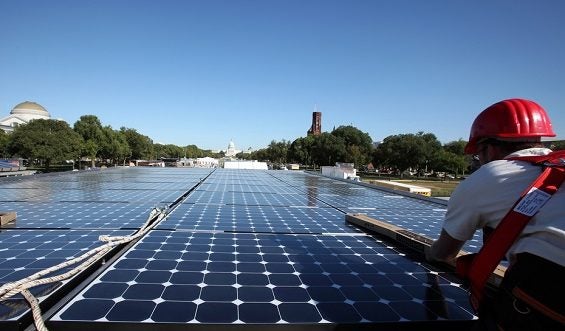Solar project will relay benefits to community

![When Georgetown University students return to classes this fall, their campus will be home to six new solar installations, totaling 1.1 MW. Together, the panels will produce 1.5 million kilowatt-hours of power, enough to save the University $3 million over the next 20 years. These types of projects are becoming routine as the cost of solar drops and institutions see solar as a smart way to reduce their energy costs. What sets this project apart from others is that it will serve to benefit more than just the University. The project came together with the help of Root + Branch, a certified benefit corporation. The company works to support projects that create what it calls ‘shared value’. Specifically, it works to harness the market in a way to benefit neighborhoods facing gentrification. “It’s clear that [solar project] developers have multiple streams of revenue, the sale of power and SRECs (solar renewable energy credits),” said Laura Recchie, Root + Branch President. “We looked at that and asked how do we create winners from that?” Root + Branch answered the question by creating a “community investment fund” using a portion of the sale of the SRECs the system will generate. SRECs represent the “green” value of the electricity generated from solar and can be sold on a market like a stock in a company. Utilities buy SRECs to comply with renewable energy goals set by the states where they operate. SRECs offer an additional revenue stream to help renewable energy pay for itself. The fund is expected to generate hundreds of thousands of dollars. This money will be used for creating low-income access to solar. Recchie said Root + Branch will be working with Georgetown faculty and students to determine how the funds are distributed. “D.C.’s solar-friendly policies are one of the main reasons we were able to attract a developer to work with us,” Recchie said. ‘The project I am describing would not be able to be done elsewhere.” This is due to the District’s strong market for SRECs. Last year, solar advocates successfully pushed for an expansion to D.C.’s renewable portfolio standard, 50% by 2032. To meet this goal, the legislation maintains aggressive alternative compliance payments. This will in turn maintain a strong demand for D.C. SRECs. This RPS expansion does not happen without solar advocates in D.C. continuing to push for strong solar policies. The Georgetown University project is a real-world example of the impact a committed community of solar activists can make.](http://www.solarunitedneighbors.org/wp-content/uploads/2017/09/Students-at-2009-Solar-Decathalon.jpg)
The project came together with the help of Root + Branch, a certified benefit corporation. The company works to support projects that create what it calls ‘shared value’. Specifically, it works to harness the market in a way to benefit neighborhoods facing gentrification.
“It’s clear that [solar project] developers have multiple streams of revenue, the sale of power and SRECs (solar renewable energy credits),” said Laura Recchie, Root + Branch President. “We looked at that and asked how do we create winners from that?”
Root + Branch answered the question by creating a “community investment fund” using a portion of the sale of the SRECs the system will generate. SRECs represent the “green” value of the electricity generated from solar and can be sold on a market like a stock in a company. Utilities buy SRECs to comply with renewable energy goals set by the states where they operate. SRECs offer an additional revenue stream to help renewable energy pay for itself.
The fund is expected to generate hundreds of thousands of dollars. This money will be used for creating low-income access to solar. Recchie said Root + Branch will be working with Georgetown faculty and students to determine how the funds are distributed.
“D.C.’s solar-friendly policies are one of the main reasons we were able to attract a developer to work with us,” Recchie said. ‘The project I am describing would not be able to be done elsewhere.”
This is due to the District’s strong market for SRECs. Last year, solar advocates successfully pushed for an expansion to D.C.’s renewable portfolio standard, 50% by 2032. To meet this goal, the legislation maintains aggressive alternative compliance payments. This will in turn maintain a strong demand for D.C. SRECs.
This RPS expansion does not happen without solar advocates in D.C. continuing to push for strong solar policies. The Georgetown University project is a real-world example of the impact a committed community of solar activists can make.
